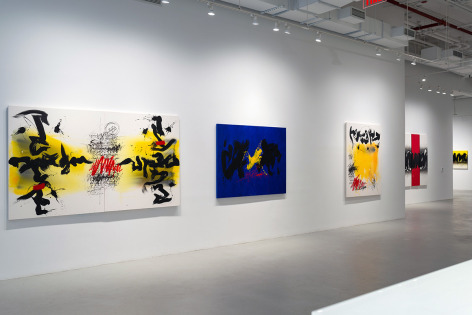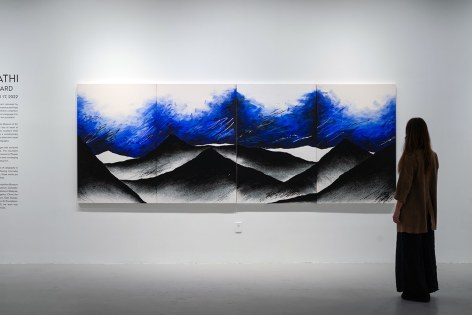We are pleased to present new abstract canvases by Golnaz Fathi, the renowned Iranian artist known for her expressive paintings rooted in the rich traditions of Persian calligraphy. For this exhibition, Fathi presents two new bodies of work in which she skillfully transforms language into pure form and explores her complicated relationship with her homeland.
Fathi, whose work is in the collections of The Metropolitan Museum of Art and the British Museum, is one of the few women in Iran to excel at traditional calligraphy. Fascinated by the expressive nature of calligraphic forms, she spent years rigorously training up to eight hours daily, learning to control her breathing and writing poetry with a qalam to master traditional strokes.
After becoming one of the country’s most skilled practitioners, Fathi left the privileged world of traditional calligraphy to pursue a career as a contemporary artist. Over time, she expanded her practice, developing a distinctive visual language derived from her reinterpretations of Persian calligraphy. It is gestural, abstract and layered with meaning.
The first series presented here inspired the exhibition title: The Road Forward. It explores Fathi’s complicated relationship with home. The works center on the mountain ranges that surround Tehran, especially Mount Damavand, Iran’s highest peak. The mountains around Fathi are more than just familiar vistas. They are entwined in Persian culture, holding a special place in myth and folklore. They are also unchanging and ever-present—a symbol of power, resistance and standing firm. The mountains are a reminder that when living under oppressive rules, one needs to continuously move forward—to keep learning and searching for the next peak to scale.
For Fathi, the process of art-making is more than a means to an end—it's a refuge and space to foster hope. “I try to make a heaven for myself in my studio,” she says. “I do what makes me feel better. I do what my heart tells me. I do what I wish. In Iran, I’ve had enough of NO. I have had enough of things dictated to me. I think I’ve been successful, because I feel happy. That’s my weapon against the regime.”
Fathi creates her landscapes from thousands of inscribed marks, similar to the practice of siah-mashq, where a calligrapher draws one letter or word repeatedly until the paper is covered with black ink to warm up the hand. The densely textured areas play against a backdrop of bold color and sweeping brushstrokes that convey movement in the sky above.
In her second new series, Fathi takes the gestural qualities of calligraphy to new heights. In a departure from earlier works, where flowing minimalist compositions are formed by a dense mesh of tiny marks, these paintings are dominated by bold, improvised brushstrokes.
Typically, Fathi doesn’t title her works, preferring to let the viewer assign their own interpretations. However, she has titled most of these paintings, including The Fire Inside Me, a dynamic large-scale diptych that speaks to her desire to be heard.
Although she is working in her familiar limited palette of red, yellow and blue, Fathi didn’t plot her colors in advance as she normally does. Nor did she create preliminary sketches. For these works, she immersed herself in the moment, tapping into the kind of creativity that arises from unconstrained movement, free of forethought or expectation.
These are action paintings. She set the canvases on the floor, spontaneously dripping and spilling paint across the surface, allowing chance to determine the forms. Syncing her movements to the rhythm of the music that always fills her studio, Fathi lost herself in the pure physicality of the process. The experience was challenging but full of joy.
Despite the improvised approach, the paintings are imbued with certainty and intention. The works demonstrate Fathi's masterful use of negative space, which she uses to create balance within the composition. Her instinct to leave large areas of the canvas white amplifies the energy and power behind each brushstroke.
Fathi recognizes her work is increasingly moving away from the highly structured discipline of calligraphy, a skill she’s deeply grateful for and one that is still foundational to her practice. “It’s two very different worlds,” she says. “I’m trained as a calligrapher, but here, I'm transforming letters into pure form. They should not be read with the eyes, but with the heart. I’m happy I've had the courage to break the rules.”
Pushing boundaries isn’t new for the artist. Her work has always been subversive, from her embrace of American Abstract Expressionism to her innovative use of materials, such as the ballpoint pen, a tool strictly forbidden to students of traditional calligraphy. With the work presented in this show, Golnaz Fathi demonstrates once again that creatively she is at her very best when she's breaking the rules.
ABOUT THE ARTIST
Golnaz Fathi (b. 1972) is part of a thriving generation of Iranian artists who grew up during the Islamic revolution and the Iran-Iraq war, a deeply isolated period of the country’s history.
Fathi has a Bachelor of Arts degree in graphic design from Azad University, Tehran, and a diploma in Iranian calligraphy from the Iranian Society of Calligraphy. She is widely recognized for expanding the tradition of calligraphy and pushing it to new heights. Her works are inspired by American Abstract Expressionists and Iranian and Middle Eastern modernists who pioneered the use of the written word as a pictorial element in the late 1950s and early 1960s. Technically brilliant, she has developed a new visual language, which reconciles the ancient with the contemporary.
Fathi’s works are in the permanent collections of The Metropolitan Museum of Art, New York; British Museum, London; Denver Art Museum, Colorado; Asian Civilisations Museum, Singapore; the Islamic Arts Museum Malaysia, Kuala Lumpur; Museum of Contemporary Art, CAA, Hangzhou, China; the World Bank, Washington, DC; Brighton & Hove Museum, East Sussex, England; Carnegie Mellon University, Doha, Qatar; the Devi Art Foundation, New Delhi; and The Farjam Collection, Dubai. In 2015, her work was exhibited in Frontiers Reimagined, a collateral event of the 56th Venice Biennale.
Golnaz Fathi has been recognized with numerous awards and accolades. In 1995, she was named Best Woman Calligraphist by the Iranian Society of Calligraphy. In 2010, she was invited to be a member of the selection committee of the renowned Sharjah Calligraphy Biennial and in the following year was chosen to be a Young Global Leader Honoree by the World Economic Forum.























